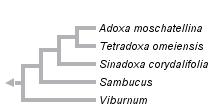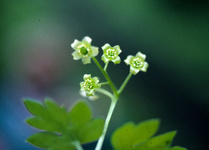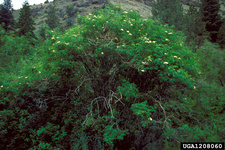Adoxaceae
Charles D. Bell


This tree diagram shows the relationships between several groups of organisms.
The root of the current tree connects the organisms featured in this tree to their containing group and the rest of the Tree of Life. The basal branching point in the tree represents the ancestor of the other groups in the tree. This ancestor diversified over time into several descendent subgroups, which are represented as internal nodes and terminal taxa to the right.

You can click on the root to travel down the Tree of Life all the way to the root of all Life, and you can click on the names of descendent subgroups to travel up the Tree of Life all the way to individual species.
For more information on ToL tree formatting, please see Interpreting the Tree or Classification. To learn more about phylogenetic trees, please visit our Phylogenetic Biology pages.
close boxReferences
Backlund, A. A. & Bremer, K. (1997): Phylogeny of the Asteridae s. str. based on rbcL sequences, with particular reference to the Dipsacales. Pl. Syst. Evol. 207:225-254.
Backlund, A. A. & Bremer, K. (1998): To be or not to be- principles of classification and monotypic plant families. Taxon 47:391-400.
Backlund, A. A. & Donoghue, M. J. (1996): Morphology and phylogeny of the order Dipsacales. In Phylogeny of the Dipsacales, A. A. Backlund, Doctoral Dissertation. Uppsala: Department of Systematic Botany, Uppsala Univ.
Backlund A. A. & Pyck, N. (1998): Diervillaceae and Linnaeaceae, two new families of caprifolioids. Taxon 47:657-661.
Bell, C. D. and M. J. Donoghue. Phylogeny and biogeography of Morinaceae (Dipsacales) based on nuclear and chloroplast DNA sequences. Organisms, Diversity, and Evolution.
Bell, C. D., Edwards, E. J., Kim, S.-T. & Donoghue, M. J. (2001): Dipsacales phylogeny based on chloroplast DNA sequences. Harvard Pap. in Bot. 6:481-499.
Blackmore, S. & Cannon, M. J. (1983): Palynology and systematics of Morinaceae. Rev. Palaeobot. and Palyn.40:207-226.
Cannon, M. J. & Cannon, J. F. M. (1984): A revision of the Morinaceae (Magnoliophyta-Dipsacales). Bull. Brit. Mus. (Nat. Hist.) Bot. 12:1-35.
Caputo, P. & Cozzolino, S. (1994): A cladistic analysis of Dipsacaceae (Dipsacales). Pl. Syst. Evol. 189:41-61.
Cronquist, A. (1988): The Evolution and Classification of Flowering Plants. New York Botanical Garden, Bronx, New York.
Donoghue, M. J. , Eriksson, T., Reeves, P. A. & Olmstead, R. G. (2001): Phylogeny and phylogenetic taxonomy of Dipsacales, with special reference to Sinadoxa and Tetradoxa (Adoxaceae). Harvard Pap. in Bot.6:459-479.
Donoghue, M. J., Bell, C. D., & Winkworth, R. C. (in press): The evolution of reproductive characters in Dipsacales. Int. J. Plant Sci.
Hofman, U. & Gottmann, J. (1990): Morina L. und Triplostegia Wall. Ex DC. Im vergleich mit Valerianaceae und Dipsacaceae. Bot. Jahrb. Syst. 111:499-553.
Judd, W. S., Sanders, R. W. & Donoghue, M. J. (1994): Angiosperm family pairs preliminary phylogenetiic analyses. Harvard Pap. in Bot. 5:1-51.
Peng, C.-I., Tobe, H. & Takahashi, M. (1995): Reproductive morphology and relationships of Triplostegia (Dipsacales). Bot. Jahrb. Syst. 116:505-516.
Pyck, N., Roels, P. & Smets, E. (1999): Tribal relationships in Caprifoliaceae: evidence from a cladistic analysis using ndhF sequences. Syst. Geogr. Pl. 69:145-159.
Pyck, N. & Smets, E. (2000): A search for the position of the seven-son flower (Heptacodium, Dipsacales): combining molecular and morphological evidence. Pl. Syst. Evol. 225:185-199.
Pyck, N., Van Lysebetten, A., Stessens, J. & Smets, E. (2002): The phylogeny of Patrinieae sensu Grabner (Valerianaceae) revisited: additional evidence from ndhF sequence data. Pl. Syst. Evol. 233:29-46.
Roels, P. & Smets, E. (1996): A floral ontogenetic study in Dipsacales. Int. J. Plant Sci. 157:203-218.
Zhang, W-H., Chen, Z-D., Li, J-H., Chen, H-B. & Tang, Y-C. (2003): Phylogeny of the Dipsacales s.l. based on chloroplast trnL-F and ndhF sequences. Mol. Phylo. Evol. 26:176-189.
Title Illustrations

| Scientific Name | Tetradoxa omeiensis |
|---|---|
| Location | China |
| Creator | Michael J. Donoghue |
| Body Part | Flower |
| Copyright |
© 2004

|
| Scientific Name | Sambucus nigra cerulea |
|---|---|
| Comments | blue elderberry, one shrub in typical habitat |
| Acknowledgements | Photograph courtesy InsectImages.org (#1208060) |
| Specimen Condition | Live Specimen |
| Source Collection | Bugwood Network/Forestry Images |
| Copyright | © Dave Powell, USDA Forest Service |
About This Page
Charles D. Bell

University of New Orleans, New Orleans, Louisiana, USA
Page copyright © 2005 Charles D. Bell
All Rights Reserved.
- First online 16 July 2004
Citing this page:
Bell, Charles D. 2004. Adoxaceae. Version 16 July 2004 (temporary). http://tolweb.org/Adoxaceae/20799/2004.07.16 in The Tree of Life Web Project, http://tolweb.org/









 Go to quick links
Go to quick search
Go to navigation for this section of the ToL site
Go to detailed links for the ToL site
Go to quick links
Go to quick search
Go to navigation for this section of the ToL site
Go to detailed links for the ToL site